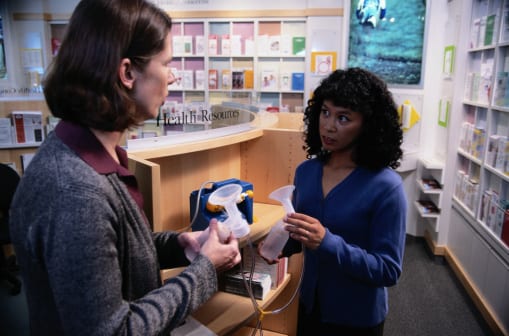A breast pump allows you to continue feeding your baby breastmilk even when you can’t always be there.
Congratulations on your decision to breastfeed your baby! You have made a thoughtful, healthy choice that research shows is best for you both. Now that you have decided to breastfeed, you’re also likely thinking of those times when you won’t be able to nurse your baby, like after you’ve returned to work, if you have to spend more than 2-3 hours away from baby, or if you develop a health condition that requires you to stop nursing for any period of time.
Having a pump to express your breast milk will keep both you and baby happy, and ensures baby is fed. There are several types of breast pumps available, and the best type for you will depend on how often you need to pump milk for your baby, and how easy it is to use and clean.
Manual versus powered pumps
If you only need to pump breast milk occasionally, a manual pump can be a good option. They’re portable and very affordable. These pumps work on only one breast at a time and do require “hand power.” We hear moms say they toss one of these in their purses or diaper bags “just in case.” Prices for these start at around $15 and go up.
If you need more frequent pumping but are still home most of the time, then a mid-range battery-powered or electric pump could be your best bet. These pumps are usually very lightweight and portable and have the advantage of no-hand pumping! Pumping can be time consuming, so pay attention to how long it takes to express the desired ounces of milk you want to express.
These pumps may or may not have adjustable suction or cycle length like their more expensive counterparts. Durability is also a concern if you’re using these pumps more frequently. They may not hold up to the use designed for hospital-grade breast pumps. Prices for these pumps are typically $60 to $150.
If you’re returning to work full-time or need to frequently pump and store milk for your baby, high-end electric pumps are best. After hospital-grade pumps, these are the most expensive pumps available; however, they’re also the most durable and customizable.
You can find pumps that will express milk from one or both breasts at the same time. They usually provide the fastest way to express your milk through variable cycle lengths and often the suction is also adjustable, which provides maximum comfort. Most models have battery backup available, as well as car adapters.
They typically have attractive carrying cases for portability, breastmilk cooling and storage. Some of the latest devices on the market even have accompanying apps to help you track your pumping sessions! Prices for these pumps start at about $300.
If you’re not ready to buy, hospital-grade electric pumps are available for rent and are great for full-time pumping needs. Check with your hospital’s lactation consultant for more details. When renting pumps, you’ll receive your own accessory kit ensuring no other mom has used the pump parts that will come in contact with your breast milk.
Buyer (or renter) beware
Don’t purchase or use a previously owned personal-use breast pump—this includes both manual and electric pumps. Most breast pumps aren’t designed to be used by more than one mother; used pumps can harbor bacteria or viruses. Avoid sharing your breast pump with another mom—even with someone you know. Hospital-grade pumps are manufactured differently and are designed to be used by more than one mother over the pump’s useful life.
Does Your Insurance Provide a Pump for You?
Did you know that the Affordable Care Act requires most health insurance plans to cover the cost of a breast pump for pregnant moms? Plans also must provide breastfeeding support, counseling and equipment while you’re breastfeeding. This applies to Health Insurance Marketplace plans and all other private health insurance plans, except for grandfathered plans. Contact your provider to see what specific equipment and breast pumps are covered under your plan. For more info, go to bit.ly/ACA_healthcare. Ask if you can acquire your pump during pregnancy—many plans will not make you wait until your baby is born to get a breast pump.
Feature Finder
Which of these common features are important to you? Check all that applies and then compare your feature list to pumps you’re considering buying or renting:
- Double electric pumps that pump both breasts at once
- Battery backup in addition to a wall plug
- Simulates the way a baby nurses at your breast
- Easy to assemble, disassemble, and clean
- Freezer tote to keep your breastmilk cool if you can’t use or access a fridge right away
- Pump storage and transport bag
- Minimal noise
Keep It Clean!
Experts at the FDA recommend taking these steps to keep your pump parts—and your milk!—clean and free from contamination:
- Use cool water to rinse pieces that come in contact with your milk as soon as possible after use
- Wash each piece separately with dish soap and warm water
- Rinse thoroughly with hot water
- Allow all parts to air dry
- If you notice tubing looking moldy or cloudy, replace it immediately
- Regularly sterilize your pump parts as directed by the manufacturer’s instructions






Comments are closed.